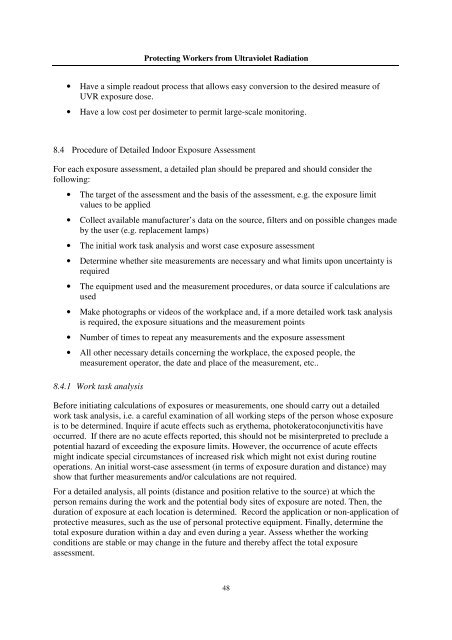Protecting Workers from Ultraviolet Radiation - icnirp
Protecting Workers from Ultraviolet Radiation - icnirp
Protecting Workers from Ultraviolet Radiation - icnirp
You also want an ePaper? Increase the reach of your titles
YUMPU automatically turns print PDFs into web optimized ePapers that Google loves.
<strong>Protecting</strong> <strong>Workers</strong> <strong>from</strong> <strong>Ultraviolet</strong> <strong>Radiation</strong><br />
• Have a simple readout process that allows easy conversion to the desired measure of<br />
UVR exposure dose.<br />
• Have a low cost per dosimeter to permit large-scale monitoring.<br />
8.4 Procedure of Detailed Indoor Exposure Assessment<br />
For each exposure assessment, a detailed plan should be prepared and should consider the<br />
following:<br />
• The target of the assessment and the basis of the assessment, e.g. the exposure limit<br />
values to be applied<br />
• Collect available manufacturer’s data on the source, filters and on possible changes made<br />
by the user (e.g. replacement lamps)<br />
• The initial work task analysis and worst case exposure assessment<br />
• Determine whether site measurements are necessary and what limits upon uncertainty is<br />
required<br />
• The equipment used and the measurement procedures, or data source if calculations are<br />
used<br />
• Make photographs or videos of the workplace and, if a more detailed work task analysis<br />
is required, the exposure situations and the measurement points<br />
• Number of times to repeat any measurements and the exposure assessment<br />
• All other necessary details concerning the workplace, the exposed people, the<br />
measurement operator, the date and place of the measurement, etc..<br />
8.4.1 Work task analysis<br />
Before initiating calculations of exposures or measurements, one should carry out a detailed<br />
work task analysis, i.e. a careful examination of all working steps of the person whose exposure<br />
is to be determined. Inquire if acute effects such as erythema, photokeratoconjunctivitis have<br />
occurred. If there are no acute effects reported, this should not be misinterpreted to preclude a<br />
potential hazard of exceeding the exposure limits. However, the occurrence of acute effects<br />
might indicate special circumstances of increased risk which might not exist during routine<br />
operations. An initial worst-case assessment (in terms of exposure duration and distance) may<br />
show that further measurements and/or calculations are not required.<br />
For a detailed analysis, all points (distance and position relative to the source) at which the<br />
person remains during the work and the potential body sites of exposure are noted. Then, the<br />
duration of exposure at each location is determined. Record the application or non-application of<br />
protective measures, such as the use of personal protective equipment. Finally, determine the<br />
total exposure duration within a day and even during a year. Assess whether the working<br />
conditions are stable or may change in the future and thereby affect the total exposure<br />
assessment.<br />
48



